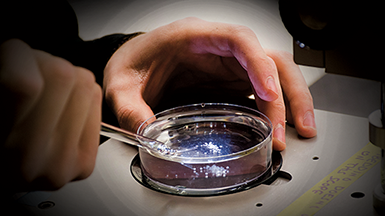Student Researchers on Path to Success
At first, the subtle blurred vision, inability to maintain concentration, and clumsiness doesn’t trigger any red flags. You chalk it up to fatigue, stress, and a very busy lifestyle. You experience some numbness in your limbs, and you detect a slight tremor in your hand. But all this comes and goes, so you really don’t pay it much mind. But gradually, things get worse and you seek the advice of a physician. After much testing, the diagnosis is a stunner: MS. Multiple Sclerosis. And there is no known cure.
Hunched over a new spinning disk confocal microscope, a cutting edge instrument to observe live specimens with high magnification, resolution, and clarity, Winona State Biology students manipulate in vivo (live) specimens of transparent Zebrafish embryos, in a search for answers to this devastating disease of the central nervous system. Under the uncompromising tutelage of Dr. Jake Hines, Assistant Professor of Biology, they might just succeed.
WSU’s reputation for impactful research draws students to the university’s science programs. And the opportunity for students to gain practical, hands-on research experience is expanding. Dr. Hines’ MS research takes its place alongside Dr. Osvaldo Martinez’s Ebola virus research, and Dr. Amy Runck’s work on “arrested development” in Eastern Tiger Salamanders, which carries implications on human aging and responses to changing environmental conditions.
In order to discover a treatment or cure for any particular disease, you must first fully understand human biology and how cells function. Dr. Hines leads his students into the intricate workings of the human cell in order to successfully conduct the research.
In Search of a Cure
MS is a chronic, quite unpredictable and often disabling disease of the central nervous system, which is made up of the brain, spinal cord, and optic nerves. Many experts maintain that MS is an immune-mediated disorder, in which the immune system incorrectly attacks healthy tissue in the central nervous system.
Symptoms, like those described earlier, occur when inflammation in the central nervous system is produced by the incorrectly functioning immune system. In short, the inflammation attacks and damages the protective fatty insulation, known as myelin sheaths, surrounding nerve fibers. When the sheaths become damaged, scar tissue forms (sclerosis) and information from the brain to the nerve is disrupted, causing symptoms to occur. As the inflammation subsides, so too do the symptoms, until the next assault. Eventually, the scar tissue damage accumulates and the symptoms become permanent. Blindness, paralysis, and death are not uncommon outcomes.
There are FDA-approved medications that help reduce the number of MS relapses a person experiences, and to delay progression of the disease, to some degree. Dr. Hines and his student research team are looking to develop a means to rebuild the damaged myelin sheaths and restore function. Regeneration of the myelin sheath is the primary goal. If they can generate a drug that robustly stimulates remyelination, it could be administered at any point to repair and restore the lost myelin, which they hope would eliminate the functional loss felt by the patient. If you eliminate the loss of the myelin sheath, you eliminate the devastation of the disease.
Dr. Hines, a first generation graduate from Ellsworth, Wis., completed his undergraduate studies at the University of Wisconsin, La Crosse. “At first I was going into social studies, then switched to health care — either a doctor or chiropractor,” said Dr. Hines. “But I had two really inspirational professors and I became addicted to science.” Dr. Hines did his graduate work at Mayo Clinic, writing grants for spinal cord research and penning research papers, and completed his post-doctoral research on nervous system development under Dr. Bruce Appel at the University of Colorado.
When an opportunity to move back to the Driftless Region, his roots, surfaced in the WSU Biology Department, Dr. Hines didn’t hesitate. And he brought his love of research with him.
“I loved the idea of coming back to a public institution with many first generation students — the first in their family to attend college. I want to make a difference for these students, some who are from my own hometown,” he said. “Some students might not have found their passion and I want to help them find their own internal drive and curiosity.”
The Measurable Benefits of Experiential Learning
So how does all this research work, in layman’s terms?
“Research projects like this are puzzle pieces,” explained Dr. Hines. “Prior research has been conducted and you build upon the discoveries — and lack thereof — of previous projects. There are hundreds of labs around the world working toward the same goal, but with different approaches. Each finding builds on the last. Up until last year, there were no FDA-approved therapies to restore myelin sheaths. One therapy showing promise is in the clinical trial stage now at the University of California, San Francisco.”
Dr. Hines’ research team is looking to restore function to already damaged cells. To understand when and how the human cell builds myelin sheath structures, one must look to the embryo where development begins. The students use specific genetically modified Zebrafish they grow and hatch in the WSU lab. Due to genetic engineering, subsets of neural cells glow different colors (green, red) under the microscope, and students can then watch the transparent embryo make myelin sheaths. To learn how the embryo makes myelin, the students inject DNA into the embryos. This DNA could show them something that they’ve never observed before, or could disrupt a particular aspect of the neural cells to learn what is necessary to build a sheath. Student researchers watch the effects of mutations through the specialized spinning disk confocal microscope and record their data.
Why Zebrafish? “You need the simplest model organisms that can satisfy the answers to the questions,” said Dr. Hines. “Zebrafish are ideal for the questions we are asking for several reasons, but perhaps most importantly because we can obtain results much more quickly than we could using mammals such as lab rats or mice. They also form myelin within their first three days when they are still optically transparent, enabling our students to look directly into the live animal to watch myelin sheaths form on nerve axons.”
There are five separate projects running concurrently in Dr. Hines’ lab, allowing students of every stage in the education cycle to participate in the research, if they are so inclined.
“Students experience the process of asking and answering questions from beginning to end,” Dr. Hines explained. “First they need to understand the fundamental question they are going to solve, and then they test it in the lab and hope they learn something new about their universe, and that biology is an approach to life.”
Watching the students transform through the years as budding scientists is one of the most rewarding parts of Dr. Hines’ job. “The students have high potential, and for many, this experience in the lab may be their first thought of being a research scientist. Watching them over the course of two or three years, weighing their options, the pros and cons of a career path, is the fun part of my job. I see them transform into adults.”
“Student research opportunities are a critical stepping stone for our students to secure professional internships and fellowships elsewhere,” Dr. Hines said. “Our students must gain experience in the lab in order to become and remain competitive in a super competitive field, and they must start early. This lab experience helps them to form decisions about their future early and makes them stand out among all those that apply for fellowships and med school.”
Long, tedious hours spent in the WSU biology lab by Dr. Hines’ students have provided promising scientific results. It is relatively common to see his students collecting data on microscopes on Friday nights and weekends. “The students are developing a tremendous work ethic, which is a key predictor of success in their futures,” commented Dr. Hines. “And they have made some really important foundational discoveries.”
The benefits to students of such research opportunities are measurable — further indication that experiential learning is critical to WSU student success.
Learn more about the WSU students involved in this research and affectionately dubbed the “Fab Five.”



